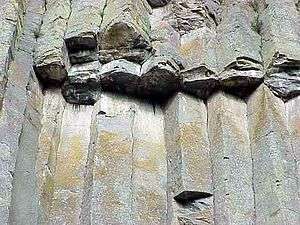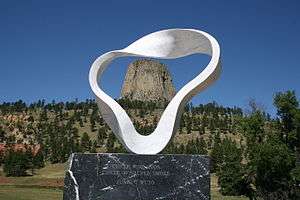Devils Tower National Monument
Devils Tower National Monument is a United States National Monument that is located in Crook County in Northeast Wyoming. The monument was established as the first national monument by President Theodore Roosevelt in 1906. The monument is the core of an ancient volcano; the surrounding softer rock has over time been eroded to reveal cooled magma hardened into igneous rock, appearing as fluted shafts and columns rising over 500 feet in the air. The monolithic tower rises above the Belle Fourche River at the edge of the Black Hills region, known in this section as the Bear Lodge Mountains.

Understand
History
The Tower was known as "Mateo Tipi" by American Indians of the region, and is considered sacred. "Mateo Tipi" translates as "Bear Lodge", as the Indian legend revolves around the creation of the tower as a refuge for a group of Indian youths being pursued by a giant bear. Imploring the great spirit to save them, a rock they were standing on began to rise into the air. The bear tried to reach them, with its claws carving the fluted columns into the rock. The youths then were taken up and became what is known as the seven sisters constellation. A U.S. cavalry scouting party reached the tower in 1876 and incorrectly translated the name to mean "Bad God's Tower" and thus its present name remains.
Devils Tower is probably best known as the location of the alien-human rendezvous point in Steven Spielberg's oscar winning 1977 Science Fiction film, Close Encounters of the Third Kind. Production designer Joe Alves traveled the west looking for a proper landmark and stumbled across the obscure park finding it a perfect fit for use in the film. Devils Tower National Monument is administered by the National Park Service, a part of the Department of Interior, and is a popular place for rock climbing, hiking, and as a tourist waypoint located between popular destinations such as Mount Rushmore National Memorial, Badlands National Park, Yellowstone National Park and Grand Teton National Park.
Landscape
The one obvious contrast in landscape here is jarringly weird, and indeed the main attraction! Devils Tower is one of the world's most striking natural monoliths in no small part for its sheer, vertical form, and its dramatic contrast with the rolling prairie extending in all directions for seemingly endless distances (the rolling prairie being essentially a lower extension of the nearby Black Hills in South Dakota).
The tower is the eroded remnant of a giant laccolith—an igneous intrusion produced by rising molten magma exploiting a weak point in the existing sedimentary rock layers about 65 million years ago. Over the epochs since, the softer sandstones and shales that covered and surrounded the intrusion (which had pushed them up), leaving us with this alien-attracting, arrestive tower. The tower is made of constantly-eroding polygonal columns of phonolite lava (similar to the columnar basalt found at the Giant's Causeway in Northern Ireland, as well as at Devils Postpile National Monument in California).

You might notice that the forest rolling along the hills is a little repetitive. The lack of diversity was caused by fire suppression by ranchers, settlers, and by the U.S. Forest and Park Services, as a means of avoiding fires spreading to settled areas and the burning down of the valuable and beautiful forests. But without the natural cycle renewal caused by (natural) forest fires, the Ponderosa pine has taken over, depriving any smaller ground plants from getting needed sunlight. In more recent decades, the Park Service has undertaken prescribed burns to try and restore the rich, diverse ecosystem that once prevailed.
Flora and fauna
Prairie falcons nest on the monument, and some climbing trails are closed yearly to protect the nestlings. Annual information about closings is available on the National Park Service web site.
The meadows on the approach roads to the Tower are the home to colonies of Prairie Dogs. Visitors are advised not to approach these creatures due to the risk of contracting rabies if bitten.
Climate
| Devils Tower National Monument | ||||||||||||||||||||||||||||||||||||||||||||||||||||||||||||
|---|---|---|---|---|---|---|---|---|---|---|---|---|---|---|---|---|---|---|---|---|---|---|---|---|---|---|---|---|---|---|---|---|---|---|---|---|---|---|---|---|---|---|---|---|---|---|---|---|---|---|---|---|---|---|---|---|---|---|---|---|
| Climate chart (explanation) | ||||||||||||||||||||||||||||||||||||||||||||||||||||||||||||
| ||||||||||||||||||||||||||||||||||||||||||||||||||||||||||||
| ||||||||||||||||||||||||||||||||||||||||||||||||||||||||||||
Get in
By air
The nearest airport with commercial service is the Gillette-Campbell County Airport (GCC IATA) in Gillette, with commuter service to Salt Lake City and Denver Airport. The closest full-service airport is Rapid City Regional Airport (RAP IATA), across the border in South Dakota and served by five airlines. US Route 14 links the two cities.
By car
Devils Tower National Monument is located off Wyoming State Route 24, which is accessed via US Route 14. The US-14/WY-24 intersection is about 1 hour east of Gillette and 1 hour and 30 minutes west of Rapid City.
Fees and permits
Park entrance fees are $10 for a private vehicle, or $5 for a hiker, bicyclist or motorcyclist. All entrance fees are valid for seven consecutive days.
There are several passes for groups traveling together in a private vehicle or individuals on foot or on bike. These passes provide free entry at national parks and national wildlife refuges, and also cover standard amenity fees at national forests and grasslands, and at lands managed by the Bureau of Land Management and Bureau of Reclamation. These passes are valid at all national parks including Devils Tower National Monument:
- The $80 Annual Pass (valid for twelve months from date of issue) can be purchased by anyone. Military personnel can obtain a free annual pass in person at a federal recreation site by showing a Common Access Card (CAC) or Military ID.
- U.S. citizens or permanent residents age 62 or over can obtain a Senior Pass (valid for the life of the holder) in person at a federal recreation site for $80, or through the mail for $90; applicants must provide documentation of citizenship and age. This pass also provides a fifty percent discount on some park amenities. Seniors can also obtain a $20 annual pass.
- U.S. citizens or permanent residents with permanent disabilities can obtain an Access Pass (valid for the life of the holder) in person at a federal recreation site at no charge, or through the mail for $10; applicants must provide documentation of citizenship and permanent disability. This pass also provides a fifty percent discount on some park amenities.
- Individuals who have volunteered 250 or more hours with federal agencies that participate in the Interagency Pass Program can receive a free Volunteer Pass.
- 4th graders can receive an Annual 4th Grade Pass that allows free entry for the duration of the 4th grade school year (September-August) to the bearer and any accompanying passengers in a private non-commercial vehicle. Registration at the Every Kid in a Park website is required.
In 2018 the National Park Service will offer four days on which entry is free for all national parks: January 15 (Martin Luther King Jr. Day), April 21 (1st Day of NPS Week), September 22 (National Public Lands Day), and November 11 (Veterans Day weekend).
Get around
Most visitors enter the park by car or bus from the east, to take a two-mile or so drive to the base of the tower on its northwest side. There they find a visitors' center with background on the park and interesting books and souvenirs. Nearby, they will find modern restrooms. From the visitors' center, they can choose to walk the full perimeter of the tower at its base on a path approximately 1.3 miles long. In primary tourists season, the more adventuresome can apply for permission to climb the tower after showing adequate preparation and qualification.
See
Now, there is one colossally, hulkingly obvious attraction here. But there's a little more to see beyond the gaping-mouthed stare the tower evokes. Hikes described below will take you around some pretty prairie landscapes and to the Belle Fourche River, as well as the occasional Japanese-crafted abstract peace statue.
Do
There is a good amount of trail here for day hiking, with the Red Beds Trail being particularly rewarding. If you're not up for a long hike, try heading up the Red Beds Trail from WY-110 near the KOA campground, which will take you to a pretty section of the Belle Fourche River, where you can see some of the old, soft red sandstone that once covered the tower.
Buy
In addition to offerings at the visitors' center, you'll find a post office and trading post just outside the park entrance. The latter offers snacks and soft drinks plus another collection of souvenirs.
Eat
The nearest restaurants are in the tiny town of Hulett (less than 400 residents) to the north on WY-24 (about a 15-minute drive from the park's gate). Sundance would be a little larger (about 1,000 residents), and has a little notoriety to the name—the Sundance Kid gets his name from his stint in the town's prison in 1888—but is a further drive, about 30 minutes southeast along WY-24 to US-14 E.
Drink
Sleep

Lodging
- Devils Tower Lodge, P.O. Box 66, #34 S.R. 110 (Drive into the Park and take the road to the Joyner Ridge Trail Head), ☎ +1-307-467-5267. A bed & breakfast that is located in a former park superintendent's home on 21 acres. Amenities include queen beds, floor-to-ceiling windows, an open-air view deck, private baths, hearty breakfasts, outdoor spa and indoor rock climbing gym/exercise room.
Camping
- Belle Fourche River Campground. The Belle Fourche River campground below Devils Tower and down the access road is first-come-first-served, no reservations accepted; a $20 fee is paid for a campsite at the drop box. There 50 campsites, no hook-ups, and due to wildfire precautions no campfires allowed, camp stove usage only. The bathrooms have running water and flush toilets, no showers. Well maintained with great views of Devils Tower.
Backcountry
Stay safe
Go next